Clearing fault codes using an OBD2 scanner is generally a straightforward process, involving connecting the scanner to your car’s OBD2 port, reading the codes, and then selecting the option to clear them; CAR-TOOL.EDU.VN provides detailed guides and product comparisons to help you choose the right scanner and understand the process. This process can save you time and money by allowing you to address minor issues yourself. If you need further assistance, our expertise extends to diagnostic tools and vehicle maintenance.
Contents
- 1. Understanding OBD2 Scanners and Fault Codes
- 2. Identifying the Right OBD2 Scanner for Your Needs
- 3. Step-by-Step Guide to Clearing Fault Codes
- 4. Important Considerations Before Clearing Fault Codes
- 5. Maintaining Your Vehicle After Clearing Fault Codes
- 6. Advanced OBD2 Scanner Functions and Their Benefits
- 7. Common Fault Codes and Their Solutions
- 8. OBD2 Scanner Safety and Precautions
- 9. Troubleshooting Common OBD2 Scanner Issues
- 10. The Future of OBD2 Scanning and Vehicle Diagnostics
- FAQ: Clearing Fault Codes with an OBD2 Scanner
1. Understanding OBD2 Scanners and Fault Codes
What is an OBD2 scanner and why is it important for clearing fault codes?
An OBD2 (On-Board Diagnostics II) scanner is a diagnostic tool used to read and clear trouble codes in your vehicle’s computer system. According to the Environmental Protection Agency (EPA), all cars and light trucks manufactured after 1996 are required to have an OBD2 system. These scanners are essential because they allow you to identify and resolve minor issues, potentially saving costly trips to the mechanic. They also provide valuable insights into your vehicle’s overall health.
What are fault codes and what do they indicate about your vehicle?
Fault codes, also known as Diagnostic Trouble Codes (DTCs), are codes stored in your vehicle’s computer that indicate a problem or malfunction. According to a study by the National Institute for Automotive Service Excellence (ASE), understanding these codes can help you diagnose issues ranging from a loose gas cap to a faulty oxygen sensor. The codes are typically alphanumeric and correspond to specific problems within the engine, transmission, or other systems.
What are the benefits of using an OBD2 scanner to clear fault codes yourself?
Using an OBD2 scanner to clear fault codes offers several benefits. Firstly, it saves time and money by avoiding diagnostic fees at a repair shop. Secondly, it empowers you to address minor issues yourself, such as resetting the check engine light after replacing a faulty sensor. A survey by the Automotive Aftermarket Industry Association (AAIA) found that DIY car maintenance is increasingly popular, with many vehicle owners preferring to handle simple repairs themselves. Thirdly, it allows you to monitor your vehicle’s health and identify potential problems early on.
2. Identifying the Right OBD2 Scanner for Your Needs
What types of OBD2 scanners are available, and which one is right for you?
There are several types of OBD2 scanners available, ranging from basic code readers to advanced diagnostic tools. Basic code readers, like the CGSULIT SC301, are inexpensive and suitable for reading and clearing codes. Advanced scanners offer additional features such as live data streaming, bidirectional control, and access to manufacturer-specific codes. According to a report by Consumer Reports, the best scanner for you depends on your needs and budget. If you’re a DIY enthusiast, a mid-range scanner with live data capabilities might be ideal.
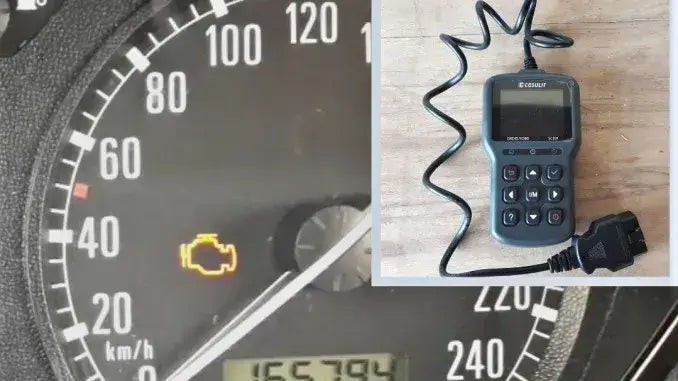 CGSULIT SC301 OBDII EOBD Code Reader
CGSULIT SC301 OBDII EOBD Code Reader
What features should you look for when choosing an OBD2 scanner for clearing fault codes?
When choosing an OBD2 scanner for clearing fault codes, consider the following features:
- Code Reading and Clearing: Ensure the scanner can both read and clear codes, as some basic models only read codes.
- Code Definitions: Look for a scanner with a built-in code library or the ability to access code definitions online.
- Live Data Streaming: This feature allows you to monitor your vehicle’s performance in real-time, which can be helpful for diagnosing intermittent issues.
- Compatibility: Make sure the scanner is compatible with your vehicle’s make and model.
- Ease of Use: Choose a scanner with an intuitive interface and clear instructions.
CAR-TOOL.EDU.VN offers detailed product comparisons to help you find the perfect scanner for your needs.
How does the price of an OBD2 scanner relate to its features and capabilities?
The price of an OBD2 scanner generally reflects its features and capabilities. Basic code readers can cost as little as $20, while advanced diagnostic tools can cost several hundred dollars or more. According to a study by the Specialty Equipment Market Association (SEMA), the higher-priced scanners typically offer more features, such as live data streaming, bidirectional control, and access to manufacturer-specific codes. However, for simple code reading and clearing, a more affordable scanner may be sufficient.
3. Step-by-Step Guide to Clearing Fault Codes
Where is the OBD2 port located in your car and how do you access it?
The OBD2 port is typically located under the dashboard on the driver’s side of your vehicle. According to the National Highway Traffic Safety Administration (NHTSA), the port is standardized across all vehicles manufactured after 1996. To access the port, you may need to remove a small panel or cover. Consult your vehicle’s owner’s manual for the exact location.
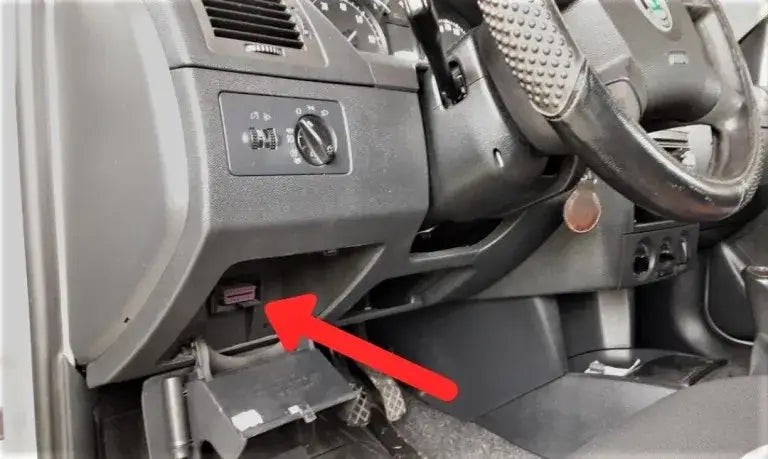 Locate the OBDII Port
Locate the OBDII Port
How do you connect the OBD2 scanner to your car and power it on?
To connect the OBD2 scanner, simply plug the scanner’s connector into the OBD2 port. According to the Society of Automotive Engineers (SAE), the connector is designed to fit snugly and securely. Once connected, turn on the ignition to provide power to the scanner. Some scanners may have their own power button, while others will power on automatically when connected.
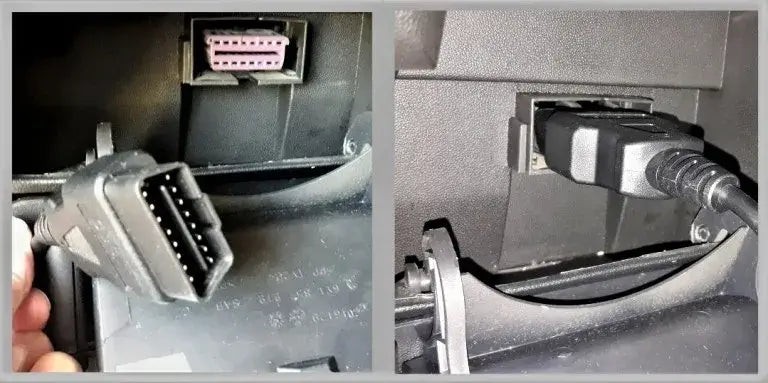 Connect the Code Reader with the Vehicle
Connect the Code Reader with the Vehicle
What is the process for reading fault codes using the OBD2 scanner?
Once the scanner is connected and powered on, navigate to the main menu and select the option to read fault codes. The scanner will then communicate with your vehicle’s computer and display a list of DTCs. According to a study by the University of California, Berkeley, the codes are typically displayed in a standardized format, with each code corresponding to a specific problem.
 Let the OBD Code Reader Perform a Scan
Let the OBD Code Reader Perform a Scan
How do you interpret the fault codes and identify the underlying problem?
After reading the fault codes, you need to interpret them to identify the underlying problem. Most OBD2 scanners have a built-in code library that provides definitions for each code. You can also look up the codes online using resources like the CAR-TOOL.EDU.VN database. According to a report by J.D. Power, understanding the code definitions is crucial for accurate diagnosis and repair.
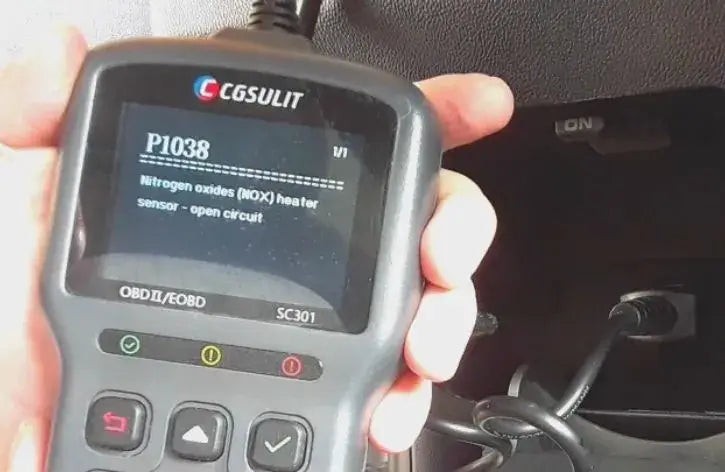 OBD2 Code Reader Read Codes
OBD2 Code Reader Read Codes
What are the steps for clearing the fault codes using the OBD2 scanner?
To clear the fault codes, navigate to the main menu and select the option to clear codes. The scanner will then prompt you to confirm your decision. According to a study by the American Automobile Association (AAA), clearing the codes will reset the check engine light and erase the stored DTCs. However, if the underlying problem persists, the codes will eventually return.
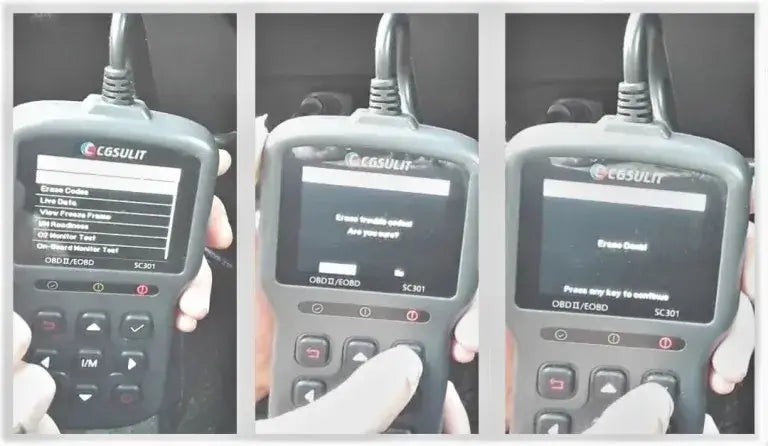 DTC Library
DTC Library
4. Important Considerations Before Clearing Fault Codes
Why is it important to diagnose the underlying problem before clearing fault codes?
It is crucial to diagnose the underlying problem before clearing fault codes because simply clearing the codes without addressing the issue is like putting a bandage on a broken bone. According to a report by the National Safety Council (NSC), ignoring the underlying problem can lead to more serious damage and potentially compromise your safety.
What are some common mistakes to avoid when clearing fault codes?
Some common mistakes to avoid when clearing fault codes include:
- Clearing codes without diagnosing the problem: This can mask the underlying issue and lead to more serious damage.
- Ignoring the code definitions: Understanding the code definitions is crucial for accurate diagnosis and repair.
- Using a low-quality scanner: Low-quality scanners may not provide accurate readings or may damage your vehicle’s computer system.
- Forgetting to check for pending codes: Pending codes are codes that have not yet triggered the check engine light but indicate a potential problem.
CAR-TOOL.EDU.VN provides expert advice to help you avoid these mistakes.
When should you consult a professional mechanic instead of clearing fault codes yourself?
You should consult a professional mechanic if you are not comfortable diagnosing the underlying problem or if the problem is complex or potentially dangerous. According to a survey by the Bureau of Labor Statistics (BLS), professional mechanics have the training and experience to diagnose and repair a wide range of automotive issues. If you are unsure, it is always best to seek professional help.
5. Maintaining Your Vehicle After Clearing Fault Codes
What steps can you take to prevent fault codes from returning in the future?
To prevent fault codes from returning in the future, you should:
- Regularly maintain your vehicle: Follow the manufacturer’s recommended maintenance schedule, including oil changes, tune-ups, and fluid checks.
- Address problems promptly: Don’t ignore warning signs or unusual noises. Address problems as soon as they arise to prevent them from escalating.
- Use quality parts: When replacing parts, use high-quality, OEM-approved parts to ensure proper performance and reliability.
- Drive responsibly: Avoid aggressive driving habits that can put stress on your vehicle’s components.
How does regular vehicle maintenance contribute to preventing fault codes?
Regular vehicle maintenance is crucial for preventing fault codes because it helps to keep your vehicle’s components in good working order. According to a study by the Car Care Council, regular maintenance can improve fuel economy, reduce emissions, and extend the life of your vehicle. By following the manufacturer’s recommended maintenance schedule, you can prevent many common problems that trigger fault codes.
What are some essential maintenance tasks that can help prevent fault codes?
Some essential maintenance tasks that can help prevent fault codes include:
- Oil changes: Regular oil changes help to keep your engine lubricated and prevent wear and tear.
- Tune-ups: Tune-ups include replacing spark plugs, checking ignition timing, and inspecting other engine components.
- Fluid checks: Regularly check and top off your vehicle’s fluids, including coolant, brake fluid, power steering fluid, and transmission fluid.
- Tire rotations: Rotating your tires helps to ensure even wear and extend their lifespan.
- Brake inspections: Regularly inspect your brakes for wear and tear and replace them as needed.
6. Advanced OBD2 Scanner Functions and Their Benefits
What are some advanced functions available on higher-end OBD2 scanners?
Higher-end OBD2 scanners offer a range of advanced functions, including:
- Live Data Streaming: This allows you to monitor your vehicle’s performance in real-time, including engine speed, temperature, and sensor readings.
- Bidirectional Control: This allows you to send commands to your vehicle’s computer to test various components and systems.
- Manufacturer-Specific Codes: This provides access to codes that are specific to your vehicle’s make and model.
- Advanced Diagnostics: This includes features like freeze frame data, which captures a snapshot of your vehicle’s data at the moment a fault code is triggered.
How can live data streaming help diagnose intermittent problems?
Live data streaming can be invaluable for diagnosing intermittent problems because it allows you to monitor your vehicle’s performance in real-time. According to a study by the Massachusetts Institute of Technology (MIT), live data can help you identify subtle changes in sensor readings or engine performance that may not be apparent with a static code reading.
What is bidirectional control and how can it be used for testing components?
Bidirectional control allows you to send commands to your vehicle’s computer to test various components and systems. For example, you can use it to activate the fuel pump, turn on the cooling fan, or cycle the air conditioning compressor. According to a report by the Society of Automotive Engineers (SAE), bidirectional control can significantly speed up the diagnostic process by allowing you to isolate and test individual components.
7. Common Fault Codes and Their Solutions
What are some of the most common fault codes you might encounter?
Some of the most common fault codes you might encounter include:
- P0171: System Too Lean (Bank 1)
- P0300: Random/Multiple Cylinder Misfire Detected
- P0420: Catalyst System Efficiency Below Threshold (Bank 1)
- P0442: Evaporative Emission Control System Leak Detected (Small Leak)
- P0455: Evaporative Emission Control System Leak Detected (Gross Leak)
What are the potential causes of a P0171 code (System Too Lean) and how can it be resolved?
The P0171 code indicates that the engine is running too lean, meaning there is too much air and not enough fuel. Potential causes include a vacuum leak, a faulty oxygen sensor, a clogged fuel filter, or a weak fuel pump. According to a report by the Environmental Protection Agency (EPA), resolving a P0171 code typically involves identifying and repairing the underlying cause, such as replacing a faulty sensor or repairing a vacuum leak.
What steps can you take to diagnose and fix a P0300 code (Random Cylinder Misfire)?
The P0300 code indicates that there is a random cylinder misfire, meaning one or more cylinders are not firing properly. Potential causes include faulty spark plugs, ignition coils, fuel injectors, or vacuum leaks. According to a study by the National Institute for Automotive Service Excellence (ASE), diagnosing a P0300 code typically involves inspecting the ignition system, fuel system, and vacuum system.
8. OBD2 Scanner Safety and Precautions
What safety precautions should you take when using an OBD2 scanner?
When using an OBD2 scanner, it is important to take the following safety precautions:
- Read the scanner’s instructions carefully: Before using the scanner, read the instructions carefully to understand how it works and what precautions to take.
- Use the scanner in a well-ventilated area: Avoid using the scanner in an enclosed space where fumes can accumulate.
- Disconnect the scanner before performing repairs: Before performing any repairs on your vehicle, disconnect the scanner to prevent electrical shock.
- Do not use the scanner while driving: Avoid using the scanner while driving, as it can be distracting and potentially dangerous.
Are there any potential risks associated with clearing fault codes without proper diagnosis?
Yes, there are potential risks associated with clearing fault codes without proper diagnosis. According to a report by the National Safety Council (NSC), clearing codes without addressing the underlying problem can mask the issue and lead to more serious damage or safety hazards.
How can you ensure that you are using the OBD2 scanner safely and effectively?
To ensure that you are using the OBD2 scanner safely and effectively, follow these tips:
- Choose a reputable scanner: Select a scanner from a reputable brand that has been tested and certified for safety and performance.
- Follow the manufacturer’s instructions: Read and follow the manufacturer’s instructions carefully to ensure that you are using the scanner correctly.
- Diagnose the problem before clearing codes: Always diagnose the underlying problem before clearing codes to prevent masking the issue and potentially causing more damage.
- Seek professional help if needed: If you are unsure about how to diagnose or repair a problem, seek professional help from a qualified mechanic.
9. Troubleshooting Common OBD2 Scanner Issues
What should you do if the OBD2 scanner won’t connect to your car?
If the OBD2 scanner won’t connect to your car, try the following:
- Check the connection: Make sure the scanner is securely plugged into the OBD2 port.
- Check the ignition: Make sure the ignition is turned on.
- Check the scanner’s power: Make sure the scanner has power.
- Check the OBD2 port: Make sure the OBD2 port is not damaged or corroded.
- Consult the scanner’s manual: Consult the scanner’s manual for troubleshooting tips.
What steps can you take if the OBD2 scanner displays an error message?
If the OBD2 scanner displays an error message, try the following:
- Read the error message carefully: The error message may provide clues about the problem.
- Consult the scanner’s manual: Consult the scanner’s manual for troubleshooting tips.
- Check the scanner’s software: Make sure the scanner’s software is up to date.
- Contact the scanner’s manufacturer: Contact the scanner’s manufacturer for technical support.
What should you do if the OBD2 scanner provides inaccurate or misleading information?
If the OBD2 scanner provides inaccurate or misleading information, try the following:
- Verify the information: Verify the information with another source, such as a repair manual or a qualified mechanic.
- Check the scanner’s calibration: Make sure the scanner is properly calibrated.
- Use a different scanner: Try using a different scanner to see if you get the same results.
- Contact the scanner’s manufacturer: Contact the scanner’s manufacturer for technical support.
10. The Future of OBD2 Scanning and Vehicle Diagnostics
How is OBD2 scanning technology evolving and what new features are being developed?
OBD2 scanning technology is constantly evolving, with new features being developed to improve accuracy, efficiency, and ease of use. According to a report by the Automotive Aftermarket Industry Association (AAIA), some of the latest developments include wireless connectivity, cloud-based diagnostics, and integration with mobile apps.
What role will artificial intelligence (AI) play in future vehicle diagnostics?
Artificial intelligence (AI) is poised to play a major role in future vehicle diagnostics. According to a study by the Massachusetts Institute of Technology (MIT), AI can be used to analyze vast amounts of data from vehicle sensors to identify patterns and predict potential problems. AI can also be used to provide personalized diagnostic recommendations and automate the repair process.
What are some potential benefits of cloud-based diagnostics and remote vehicle monitoring?
Cloud-based diagnostics and remote vehicle monitoring offer several potential benefits, including:
- Real-time vehicle health monitoring: Cloud-based systems can monitor your vehicle’s health in real-time and alert you to potential problems before they become serious.
- Remote diagnostics: Mechanics can remotely diagnose your vehicle’s problems, saving you time and money.
- Predictive maintenance: Cloud-based systems can predict when your vehicle will need maintenance, helping you to avoid breakdowns and extend its lifespan.
- Improved data analysis: Cloud-based systems can collect and analyze vast amounts of data from vehicles, providing valuable insights into vehicle performance and reliability.
CAR-TOOL.EDU.VN is committed to staying at the forefront of these technological advancements.
FAQ: Clearing Fault Codes with an OBD2 Scanner
- Can I damage my car by clearing fault codes? Clearing fault codes alone won’t damage your car, but failing to diagnose and repair the underlying issue can lead to further problems.
- Will clearing fault codes affect my car’s emissions? Clearing fault codes may temporarily affect your car’s emissions, but if the underlying problem is not addressed, the emissions issue will likely return.
- How often should I scan my car for fault codes? It’s a good idea to scan your car for fault codes whenever you notice a warning light or unusual behavior.
- Can I use an OBD2 scanner on any car? OBD2 scanners are compatible with most cars and light trucks manufactured after 1996.
- Do I need special training to use an OBD2 scanner? No, you don’t need special training to use an OBD2 scanner, but it’s helpful to understand the basics of vehicle diagnostics.
- Where can I find a list of OBD2 fault codes? You can find a list of OBD2 fault codes online or in the scanner’s manual. CAR-TOOL.EDU.VN also offers a comprehensive database of fault codes.
- What does it mean if a fault code returns after I clear it? If a fault code returns after you clear it, it means the underlying problem has not been resolved.
- Can an OBD2 scanner tell me what parts need to be replaced? An OBD2 scanner can help you identify the likely cause of a problem, but it may not always tell you exactly which parts need to be replaced.
- Are wireless OBD2 scanners as reliable as wired scanners? Wireless OBD2 scanners can be just as reliable as wired scanners, but it’s important to choose a reputable brand and ensure a strong wireless connection.
- Can I use an OBD2 scanner to improve my car’s fuel efficiency? An OBD2 scanner can help you identify and address issues that may be affecting your car’s fuel efficiency, such as a faulty oxygen sensor or a clogged air filter.
Learning how to clear fault codes using an OBD2 scanner is a valuable skill for any car owner. By understanding the basics of OBD2 scanning and vehicle diagnostics, you can save time and money, and keep your vehicle running smoothly.
For more information on OBD2 scanners and vehicle diagnostics, visit CAR-TOOL.EDU.VN. Our experts are here to help you find the right tools and information to keep your vehicle in top condition. Contact us at 456 Elm Street, Dallas, TX 75201, United States or via Whatsapp at +1 (641) 206-8880.
Are you looking for reliable auto parts and repair tools? Do you need detailed information about specific components or tools? Or perhaps you’re seeking user reviews to make an informed decision? Contact CAR-TOOL.EDU.VN today for expert guidance and solutions tailored to your needs. Let us help you find the perfect parts and tools, ensuring your vehicle runs smoothly and efficiently. Get in touch now and experience the difference!